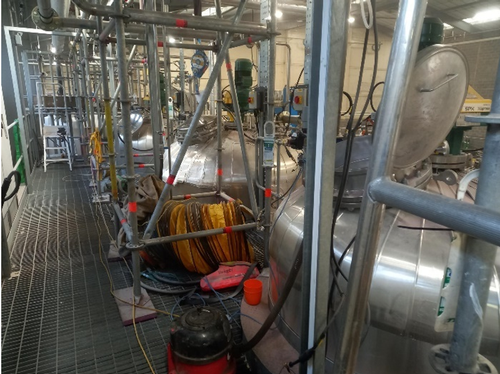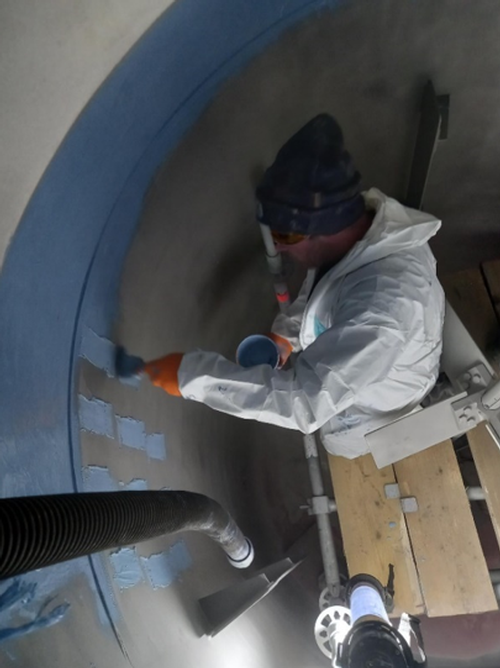THURSDAY, MAY 9, 2024
International protective coatings and composites manufacturer Belzona recently provided anti-corrosive coatings to protect the internal lining of biotechnology company CuanTec's tanks at a production plant in Scotland.
According to an emailed case study from Belzona, these tanks were coated to mitigate future damage, as the tanks play a large role in turning shellfish byproduct into the biopolymer chitosan.
About the Project
CuanTec has reportedly worked to build a circular economic business model to help reduce the carbon footprint from unnecessary disposal of unused shells within the shellfish industry, converting it into chitosan products.
According to data provided by the United Nations, food waste has contributed to 8% of global greenhouse gas emissions, meaning that if food waste was a country, it would be the third-largest emitting country in the world.
At the 2023 United Nations Climate Change Conference, negotiators from 200 parties agreed on the data from the Intergovernmental Panel on Climate Change that GHG emissions need to be cut back by 43% by 2030 to limit warming to 1.5 degrees Celsius (2.7 degrees Fahrenheit) by 2050, aligning with the Paris Agreement.

 |
| Photos: Belzona |
|
International protective coatings and composites manufacturer Belzona recently provided anti-corrosive coatings to protect the internal lining of biotechnology company CuanTec's tanks at a production plant in Scotland. |
Circular business models like the one offered by CuanTec have reportedly worked to play an important role in mitigating carbon footprints and limiting global warming to 1.5 C.
The study also emphasized the importance of assets within these types of businesses, like machinery, equipment, buildings and structures being safeguarded to a specific standard. If not properly protected, damage and wear can reportedly harm the integrity of assets, undermining the environmental benefits these types of business models offer.
Several industries are utilizing industrial repair composites and high-performance coatings to bypass this replacement process to repair, protect and potentially improve assets that would otherwise be decommissioned and sent to landfill.
Because of this, Belzona says that polymeric technology may have a larger part to play in the decarbonization of several sectors, supporting a net zero by 2050 pathway.
CuanTec reportedly aimed to utilize the three steel tanks for turning shellfish shell into chitosan products, made to specific technical specifications of their customers.
According to Belzona, the tanks had already been in use elsewhere, but were still in good condition. To ensure the tanks could withstand the harsh chemicals they would come into contact with, CuanTec decided to implement polymeric technology as protection.
 |
|
According to Belzona, the tanks had already been in use elsewhere, but were still in good condition. To ensure the tanks could withstand the harsh chemicals they would come into contact with, CuanTec decided to implement polymeric technology as protection. |
Belzona's 1391T coating was specified for the project after an inspection from Clive Leadbitter, Senior Field Sales Engineer at authorized Belzona Distributorship, Belzona U.K. This system can reportedly protect assets against corrosion in aggressive and acidic environments, as well as suit the steel substrate in this specific application.
Additionally, since Belzona 1391T can be applied without the need for hot work, this could help to ensure that the application was carried out as quickly as possible, while also reducing the health and safety risks that arise when hot work is involved.
“Surface preparation was carried out by grit-blasting. Following this, using a stiff-bristled brush, two coats of Belzona 1391T were applied at a thickness of 450 µm (17.72 mil) per coat. Once the application had cured within the space of 24 hours, the application was complete,” Clive said.
Other Belzona Studies
In March, Belzona announced that Rezitech, an authorized Belzona distributor, provided a wrapping to help fight corrosion under insulation on an ammonium sulphate feed tank at a blue-chip nickel mine in Australia.
According to an emailed release, within 24 hours, the 9.5-meter (31.2-foot) diameter tank, with a height of 2 meters from ground level, was repaired and protected against future corrosion with the industrial composite wrap system, Belzona SuperWrap II.
Belzona stated that the mine works to refine granulated nickel matte from their smelter into nickel powder and briquettes with 99.8% nickel. According to the release, the nickel powder is then processed into nickel sulphate at a refinery in Australia.
The release explained that nickel sulphate is a major ingredient in the lithium-ion batteries that drive electric vehicles.
Belzona explained that the refinery's stainless-steel feed tank was experiencing corrosion under insulation and chloride induced stress corrosion cracking. Workers reportedly needed a solution that could restore the integrity on the substrate, while also protecting the asset against future corrosion damage.
Additionally, as the tank operates at elevated temperatures of around 70 degrees Celsius (158 degrees Fahrenheit) and processes highly corrosive medium, the repair solution would reportedly need to be able to handle these harsh conditions.
Belzona decided to contact Rezitech for its advice and system recommendations. After an inspection by Heath Westell, Sales Engineer at Rezitech, composite wrap system Belzona SuperWrap II was reportedly recommended.
To begin, all traces of oil and grease contamination were reportedly removed with a suitable Rezitech Degreaser. Afterwards, the surfaces were grit-blasted to give a surface cleanliness compliant with ISO 8501-1 SA 2½ (ASNZ 1627.4 class 2.5) with a minimum 75 µm (3 mil) rough angular profile.
Next, the Belzona 9381 reinforcement sheet was measured out and then wetted with the Belzona resin system, which was then systematically applied to the areas to be repaired. Following this, the Belzona reinforcement sheets were reportedly applied to the tank in three layers.
Belzona stated that the compression film was added to the top of the application area, and, using a roller, the Belzona SuperWrap II composite wrap system was then spread, rolled and compressed to the surface of the tank. The system was then reportedly left to cure for around eight hours.
Belzona stated that its composite wrap solution helped the tank owner successfully bypass the need to replace the corroded asset, instead prolonging the lifespan of the structure.
Tagged categories: Belzona; Bio-based materials; Bioproducts; Carbon dioxide; Carbon footprint; Case History; Coating Application; Completed projects; Corrosion; Corrosion protection; Environmental Protection; Erosion; Health and safety; Polymers; Program/Project Management; Protective coatings; Safety; Sustainability; Tanks